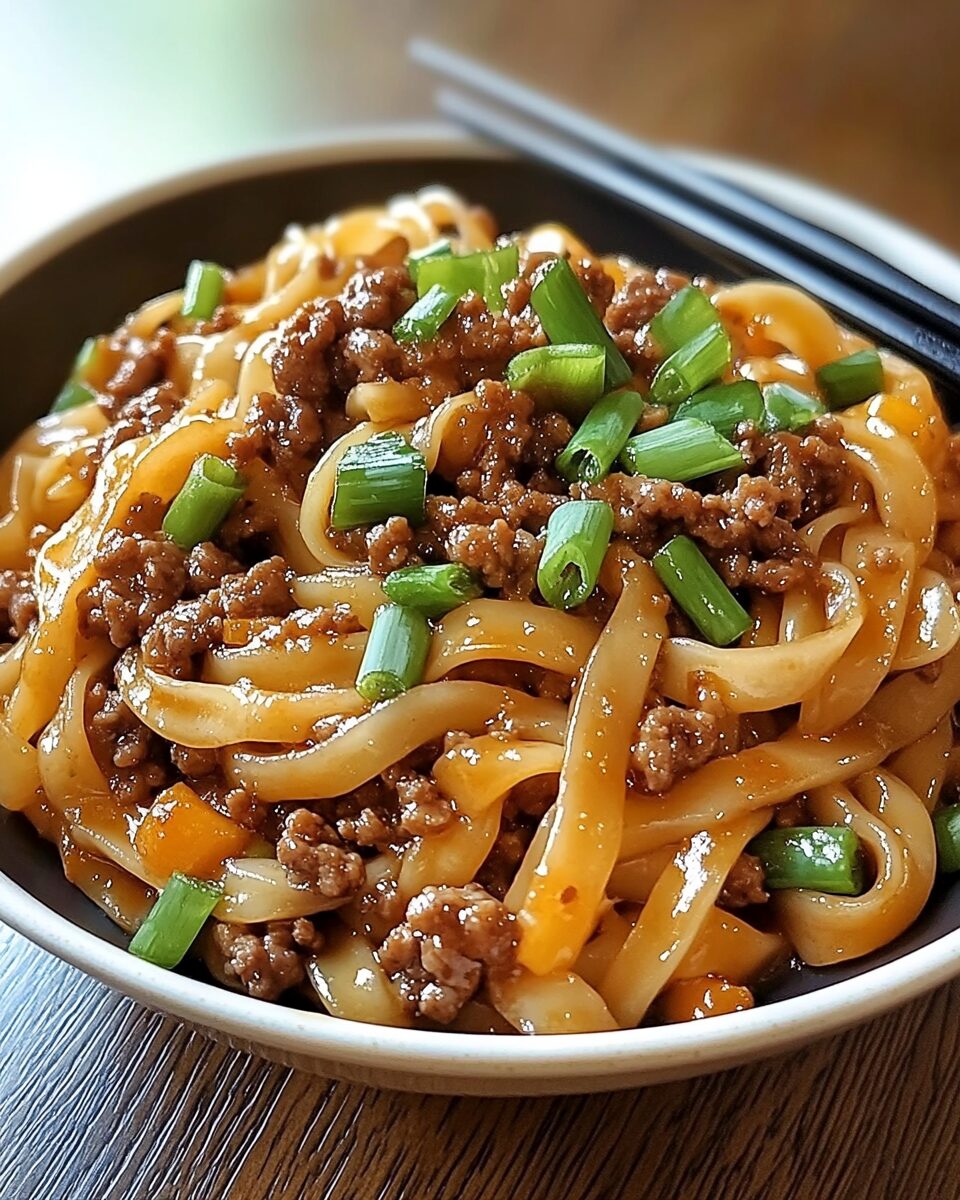Mongolian Ground Beef Noodles are the ultimate weeknight dinner solution. With tender noodles tossed in a rich, garlicky, and slightly sweet Mongolian style sauce, this dish is a perfect balance of bold flavors and hearty satisfaction. The ground beef soaks up the delicious blend of soy sauce, hoisin, and brown sugar, while a pinch of red pepper flakes adds a subtle heat.
This dish is versatile and easy to customize swap out the protein, adjust the spice level, or throw in your favorite veggies for a personal touch. Whether you’re cooking for a busy family or just want a restaurant-quality meal at home, this noodle dish delivers big flavor with minimal effort.
Full Recipe:
Ingredients:
- 1 lb ground beef (lean preferred)
- 5 cloves garlic, minced
- 1/3 cup brown sugar
- 1/4 cup beef broth
- 1/3 cup soy sauce (low sodium if preferred)
- 3 tablespoons hoisin sauce
- 1/2 teaspoon ground ginger
- 1/2 teaspoon ground black pepper
- Pinch of red pepper flakes (optional)
- 10 oz linguine (or substitute with spaghetti, rice noodles, or gluten-free pasta)
- 1 tablespoon cornstarch
- 2 tablespoons water
- 4 green onions, sliced (for garnish)
Directions:
- Cook the linguine in a large pot of salted boiling water until al dente. Drain and set aside.
- While the pasta cooks, heat a large skillet over medium-high heat. Add the ground beef and cook until browned, breaking it up as it cooks. Drain excess fat.
- Reduce heat to medium, add the minced garlic, and sauté for 1 minute until fragrant.
- Stir in the soy sauce, beef broth, brown sugar, hoisin sauce, ground ginger, black pepper, and red pepper flakes (if using). Mix well to blend flavors.
- In a small bowl, whisk together the cornstarch and water until smooth. Add to the skillet and stir. Let the sauce simmer until thickened.
- Add the cooked linguine to the skillet and toss until fully coated. Let it simmer for 2-3 minutes to absorb flavors.
- Garnish with sliced green onions and serve hot.
Prep Time: 10 minutes | Cooking Time: 15 minutes | Total Time: 25 minutes
Kcal: ~450 kcal | Servings: 4 servings
Mongolian Ground Beef Noodles: A Flavorful and Easy Weeknight Meal
Mongolian Ground Beef Noodles is a quick, satisfying dish packed with bold flavors and rich umami. This meal takes inspiration from classic Mongolian beef, a popular Asian American dish known for its savory-sweet sauce, and pairs it with tender noodles to create a hearty, comforting dinner. Whether you’re looking for a fast weekday meal or an alternative to takeout, this dish is easy to make, full of depth, and customizable to fit various dietary needs.
Why You’ll Love This Recipe
- Quick & Easy – This meal comes together in under 30 minutes, making it ideal for busy weeknights.
- Affordable Ingredients – Uses common pantry staples like soy sauce, brown sugar, and garlic, keeping it budget-friendly.
- Restaurant-Quality Flavor – A rich combination of sweet, savory, and umami-packed sauce gives this dish a delicious depth.
- Customizable – Easily adjust the spice level, swap proteins, or add vegetables for extra nutrients.
- Great for Meal Prep – Stores well and tastes even better the next day as the flavors deepen.
The History Behind Mongolian Beef
Despite its name, Mongolian beef does not originate from Mongolia. Instead, it is an Asian-American dish that was popularized in Chinese restaurants in the United States. The dish typically consists of thinly sliced beef stir-fried in a sweet and savory brown sauce made from soy sauce, hoisin sauce, ginger, garlic, and sugar. Over time, variations of Mongolian beef have evolved, incorporating different proteins and ingredients.
Mongolian Ground Beef Noodles take inspiration from this dish by using ground beef instead of sliced flank steak, making it more affordable and quicker to prepare. The addition of noodles transforms it into a complete meal, adding heartiness while allowing the flavorful sauce to coat every strand for a delicious bite.
The Secret to a Perfect Mongolian Sauce
The sauce is the star of this dish, providing a perfect balance of salty, sweet, and umami-rich flavors. Here’s what makes it special:
- Soy Sauce – This is the backbone of the sauce, delivering deep umami flavor. Using a low-sodium version allows you to control the saltiness.
- Brown Sugar – Adds sweetness to balance the savory flavors while caramelizing slightly for depth.
- Hoisin Sauce – A fermented soy-based sauce that brings additional sweetness, tang, and umami.
- Garlic & Ginger – Essential aromatics that give the dish its signature Asian-inspired taste.
- Beef Broth – Enhances the richness of the sauce while keeping it from becoming too thick.
- Cornstarch Slurry – Helps thicken the sauce, ensuring it coats the noodles perfectly without being too watery.
- Red Pepper Flakes (Optional) – Adds a hint of heat, balancing the sweetness for a well-rounded taste.
Choosing the Right Noodles
One of the best things about this dish is how versatile it is when it comes to noodles. While the original recipe uses linguine, several other options work just as well:
- Spaghetti or Fettuccine – A great substitute if you don’t have linguine on hand.
- Rice Noodles – Perfect for a gluten-free version while maintaining a similar texture.
- Lo Mein Noodles – A more traditional Chinese noodle that absorbs sauce beautifully.
- Ramen Noodles – Adds a slightly chewy texture and soaks up the sauce well.
- Zucchini Noodles – A great low-carb alternative that still pairs well with the Mongolian beef sauce.
Each noodle type provides a slightly different texture, so feel free to experiment to find your favorite.
Customization and Variations
This dish is incredibly adaptable, making it a great option for different dietary needs or flavor preferences. Here are a few ways you can modify the recipe:
1. Swap the Protein
- Ground Turkey or Chicken – A leaner alternative with a slightly lighter taste.
- Tofu or Tempeh – For a vegetarian version, crumble firm tofu or use tempeh to mimic the texture of ground beef.
- Shrimp – Adds a seafood twist to the dish while maintaining a rich, umami-packed flavor.
2. Add Vegetables
Incorporating vegetables enhances the nutritional value and adds vibrant color to the dish. Some great options include:
- Bell peppers
- Carrots (julienned)
- Snap peas
- Broccoli
- Mushrooms
- Baby spinach
Adding vegetables not only boosts the health factor but also provides additional textures and flavors.
3. Make it Spicy
If you love heat, there are several ways to increase the spice level:
- Add extra red pepper flakes.
- Drizzle in some Sriracha or chili oil.
- Stir in diced fresh chili peppers for a bold kick.
4. Make it Low-Carb or Keto-Friendly
For a lower-carb version, you can replace the noodles with:
- Zucchini noodles
- Spaghetti squash
- Shirataki noodles (zero-carb alternative)
You can also slightly reduce the brown sugar to minimize the overall carbohydrate content while keeping the flavors balanced.
Serving Suggestions
Mongolian Ground Beef Noodles can be enjoyed as a complete meal on their own, but they also pair wonderfully with simple side dishes. Some great options include:
- Steamed Vegetables – Broccoli, bok choy, or green beans complement the dish beautifully.
- Side Salad – A fresh cucumber or mixed greens salad with a light dressing balances the richness.
- Egg Rolls or Spring Rolls – For a more indulgent meal, serve with crispy spring rolls.
- Dumplings – Pairing with potstickers or steamed dumplings enhances the Asian-inspired experience.
For a fun twist, you can also serve the Mongolian beef mixture over white rice or fried rice instead of noodles.
Storage and Reheating Tips
This dish stores well, making it an excellent option for meal prep.
- Refrigeration – Store leftovers in an airtight container in the fridge for up to 3 days.
- Freezing – While the beef sauce freezes well, noodles tend to become mushy. If planning to freeze, store the sauce separately and cook fresh noodles when ready to eat.
- Reheating – Warm the dish on the stovetop over medium heat, adding a splash of beef broth or water to loosen the sauce. If using a microwave, heat in short intervals, stirring in between to avoid drying out the noodles.
Common Mistakes to Avoid
- Overcooking the Pasta – Always cook pasta al dente, as it will continue to absorb sauce when mixed.
- Not Draining Excess Grease – If using fatty ground beef, draining excess grease prevents the dish from becoming overly greasy.
- Skipping the Cornstarch Slurry – Without cornstarch, the sauce may be too thin and won’t coat the noodles properly.
- Overloading with Sugar – While brown sugar adds depth, too much can make the dish overly sweet. Adjust based on personal preference.
Conclusion
Mongolian Ground Beef Noodles is a fantastic dish that brings bold flavors and comforting textures together in one simple recipe. With its savory-sweet sauce, tender ground beef, and perfectly coated noodles, this meal is a surefire crowd-pleaser. Whether you make it as a quick weeknight dinner or a make-ahead meal, it offers restaurant-quality taste with minimal effort.
The best part? It’s incredibly flexible! You can tweak the spice level, swap proteins, add veggies, or even make it low-carb to fit your dietary needs. Once you try this recipe, it will likely become a staple in your meal rotation.
So the next time you’re craving takeout, skip the delivery and whip up these Mongolian Ground Beef Noodles instead you won’t be disappointed!






